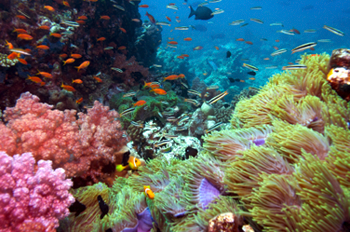Now that Hurricane Sandy has passed and buildings, infrastructure, and lives are beginning to be rebuilt there are still many important conversations to be had. For starters, there may be lingering and long-term public health risks that are no less important now weeks after flooding events. And what about the next big storm? Will we be prepared for it? Natural defense systems, such as properly functioning wetlands and river deltas, should be part of this conversation in addition to built structures like seawalls and levees.
This post is part of a series on Hurricane Sandy: Confronting the Realities of Climate Change.
Not only can such natural defense systems reduce vulnerability to and impacts from events like Sandy, but they can often be done less expensively than built solutions while providing other important benefits at the same time.
A third way to adapation and resilience?
Adaptation to climate change and associated impacts has previously been grouped into so-called “soft” and “hard” approaches. The “soft” approaches include generating and spreading relevant information, raising public awareness, and ensuring functioning institutions, such as public health departments. The “hard” approaches focus more on the built environment, such as seawalls and levees. It has been suggested that ecosystem-based adaption can provide a third way towards building resilience against climate impacts.
The beauty of relying on natural, healthy ecosystems is that they provide a wide array of services and valuable potential co-benefits, including air quality regulation, water purification, genetic resources, food, livelihoods and jobs, tourism and recreation, and even spiritual and aesthetic values. With coastal storms like Sandy, however, the important benefits are in coastal protection.
Mangroves, coral reefs, and river deltas
Healthy coastal ecosystems can provide defenses against dangerous storm surges that can inundate coastlines. Mangrove forests include various types of trees that all grow in coastal, saltwater environments, including areas in the Caribbean and along the Gulf Coast. Mangroves essentially provide a break against damaging waves by reducing their height before reaching further inland and causing damage. In fact, one study found that areas with mangroves experienced significantly less deaths than those without when a cyclone struck India in 1999.

Healthy coral reef ecosystems not only provide natural protection against coastal flooding, but bring many other benefits including productive fisheries and tourism. These can provide a great deal of support for local economies. Photo credit: NOAA
Coral reef systems function in much the same way as mangroves. They provide surfaces that can break up waves before pounding the coastline. Up to 90 percent of the energy from waves can be absorbed by reef structures and this can have substantial value in avoided coastal impacts. Reefs also provide services beyond protection from storm surge. They serve as critical habitat for numerous marine species and have been called the “rainforests of the ocean.” This can lead to economic benefits through local fishing industries (in part by providing productive spawning grounds for fish), recreational tourism, and the many under-appreciated benefits of biodiversity.
For areas that don’t have mangroves and reefs (e.g. much of the U.S. East Coast), other natural defenses can reduce storm impacts. Barrier islands like those along North Carolina and New Jersey can shield the coastline behind them. Likewise, properly functioning river deltas and wetlands can reduce storm surge and flooding vulnerability. A degraded Mississippi River delta has been implicated in increasing the vulnerability of New Orleans and surrounding areas to storms like Katrina and Rita.
Natural approaches can be cost-effective
A recent review study took some case studies and put dollar figures on ecosystem-based adaptation versus hard infrastructure. For instance, in the Maldives, an island nation threatened by sea level rise, it is estimated to cost $1.6-2.7 billion to replace natural reefs with built protection like seawalls. In contrast, the cost of preserving existing reefs may be only in the tens of millions of dollars per year, with potential co-benefits of around $10 billion annually in tourism and fisheries.
Likewise, restoration of wetlands around New Orleans is estimated to a few dollars per square meter. The return on wetlands in the Mississippi delta is estimated at $12-47 billion per year in total ecosystem services. A flood wall can be heightened by one meter for $7-8 million per kilometer. This can reduce flood risk, but does not provided the additional value through the many ecosystem services of natural defenses.
These defenses could be fleeting
Global change has not been kind to these natural defenses and is putting their continued services at risk. Coral reef systems face numerous threats from many different directions. Overfishing, development, and agricultural pollution run-off have been culprits historically. Now ocean acidification and rising water temperatures have emerged as serious threats and both stem from carbon emissions. These trends are projected to continue, increasing the impacts to reefs.
Mangroves also are being lost with some estimates at 30-50 percent globally since the 1940s. These losses are due, in part, to development, sea level rise, and pollution drainage. This is especially troubling as mangroves, along with sea grasses and salt marshes, have been termed “blue carbon” and are significant carbon sinks. Not only are we losing them as a player in climate adaptation, but we are also losing them in climate mitigation. However, recent work has shown that if carbon emissions were to be priced at a modest $10 per ton then mangrove habitat destruction could be greatly reduced. It would become more valuable from a dollars and cents perspective to leave mangroves intact.
Ecosystem-based adaptation may not be appropriate or applicable in every case. However, it should definitely be explored as an option when possible. Not only do we get resilience and protection from damaging coastal storms, but it often comes with lower net costs and myriad other ecosystem benefits for free. That cannot be said about simply building a higher levee.

